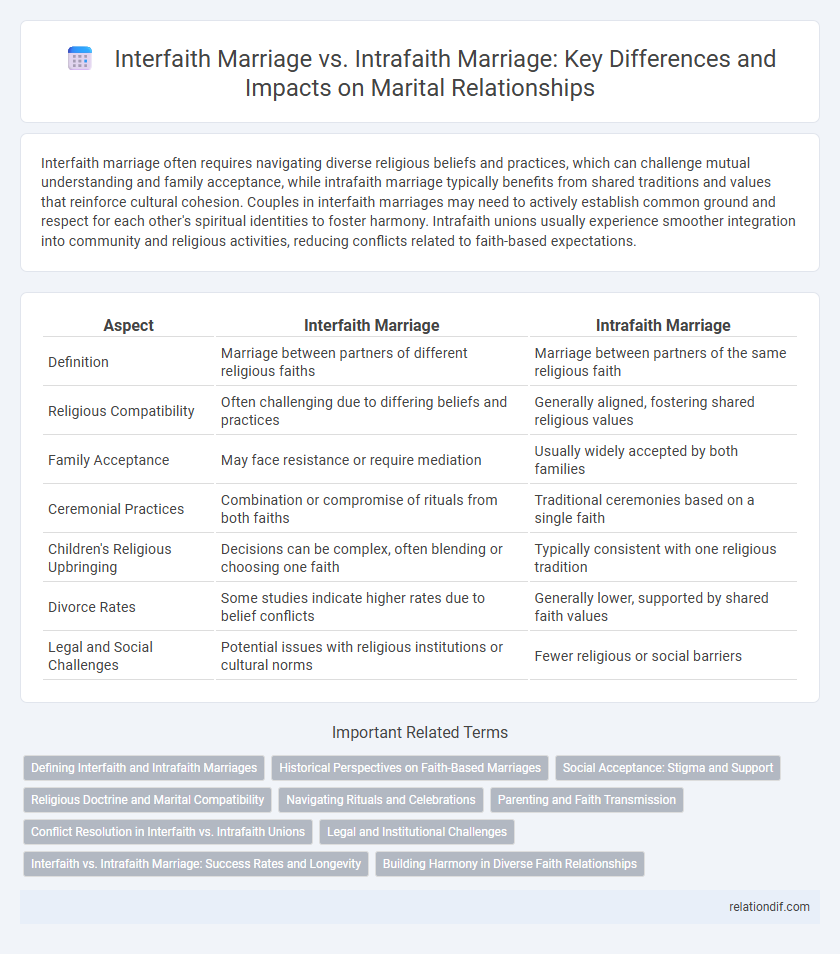Interfaith marriage often requires navigating diverse religious beliefs and practices, which can challenge mutual understanding and family acceptance, while intrafaith marriage typically benefits from shared traditions and values that reinforce cultural cohesion. Couples in interfaith marriages may need to actively establish common ground and respect for each other's spiritual identities to foster harmony. Intrafaith unions usually experience smoother integration into community and religious activities, reducing conflicts related to faith-based expectations.
Table of Comparison
| Aspect | Interfaith Marriage | Intrafaith Marriage |
|---|---|---|
| Definition | Marriage between partners of different religious faiths | Marriage between partners of the same religious faith |
| Religious Compatibility | Often challenging due to differing beliefs and practices | Generally aligned, fostering shared religious values |
| Family Acceptance | May face resistance or require mediation | Usually widely accepted by both families |
| Ceremonial Practices | Combination or compromise of rituals from both faiths | Traditional ceremonies based on a single faith |
| Children's Religious Upbringing | Decisions can be complex, often blending or choosing one faith | Typically consistent with one religious tradition |
| Divorce Rates | Some studies indicate higher rates due to belief conflicts | Generally lower, supported by shared faith values |
| Legal and Social Challenges | Potential issues with religious institutions or cultural norms | Fewer religious or social barriers |
Defining Interfaith and Intrafaith Marriages
Interfaith marriage refers to a union between partners belonging to different religious faiths, often involving distinct beliefs, rituals, and cultural practices. Intrafaith marriage occurs when both individuals share the same religious tradition, promoting greater cohesion in spiritual values and worship. Understanding the differences between interfaith and intrafaith marriages highlights the unique challenges and strengths associated with religious compatibility in marital relationships.
Historical Perspectives on Faith-Based Marriages
Historical perspectives on faith-based marriages reveal distinct social and cultural dynamics between interfaith and intrafaith unions. Intrafaith marriages traditionally reinforced religious homogeneity, community cohesion, and shared rituals, whereas interfaith marriages often faced social resistance due to differences in beliefs and practices. Over time, evolving societal values and increased religious pluralism have transformed perceptions, leading to greater acceptance of interfaith marriages in many regions.
Social Acceptance: Stigma and Support
Interfaith marriages often face greater social stigma and challenges in gaining acceptance compared to intrafaith marriages, as differing religious beliefs can lead to misunderstandings and resistance within both communities. Intrafaith marriages typically experience stronger support networks due to shared customs, values, and religious practices reinforcing communal bonds. Social acceptance in interfaith unions improves significantly when couples actively engage in intercultural dialogue and foster mutual respect, bridging gaps between diverse religious groups.
Religious Doctrine and Marital Compatibility
Religious doctrine plays a critical role in both interfaith and intrafaith marriages, influencing the expectations and practices upheld by each partner. Intrafaith marriages often benefit from shared beliefs and rituals, fostering stronger marital compatibility through common values and religious understanding. Interfaith couples may face challenges in aligning their spiritual practices but can achieve harmony by embracing mutual respect and open communication about their differing religious doctrines.
Navigating Rituals and Celebrations
Interfaith marriages often require careful negotiation and blending of distinct religious rituals and celebrations to respect both partners' traditions, fostering mutual understanding and harmony. Intrafaith marriages typically experience smoother integration of ceremonies as both partners share similar religious backgrounds and practices, allowing for more cohesive observance. Successful navigation of these dynamics involves open communication, willingness to adapt, and sometimes creating new joint customs that honor both faith identities.
Parenting and Faith Transmission
Interfaith marriage often presents distinct challenges in parenting, as couples navigate differing religious beliefs and practices while raising children, potentially leading to diverse faith expressions and negotiations on religious education. Intrafaith marriages typically provide a more unified framework for faith transmission, allowing parents to reinforce consistent religious values and traditions within the family. Studies show that children in intrafaith households are more likely to adopt the parents' religion, whereas interfaith families frequently encourage more individualized spiritual exploration.
Conflict Resolution in Interfaith vs. Intrafaith Unions
Interfaith marriages often require more complex conflict resolution strategies due to differing religious beliefs, practices, and family expectations, which can lead to misunderstandings and tension. Intrafaith marriages benefit from shared religious values and traditions, providing a common foundation that eases communication and dispute resolution. Effective conflict resolution in interfaith unions frequently involves open dialogue, respect for diverse perspectives, and sometimes mediation to navigate religious differences constructively.
Legal and Institutional Challenges
Interfaith marriage often faces complex legal challenges, including restrictions on solemnization, recognition, and inheritance rights varying significantly across jurisdictions. Intrafaith marriage typically benefits from clearer institutional support, aligning with religious and cultural norms that simplify legal processes and community acceptance. Both types of marriages must navigate issues such as spousal rights, child custody, and identity documentation, but interfaith unions frequently encounter additional hurdles due to conflicting religious laws and societal attitudes.
Interfaith vs. Intrafaith Marriage: Success Rates and Longevity
Interfaith marriages, involving partners from different religious backgrounds, often face unique challenges related to cultural and religious differences, which can impact communication and conflict resolution. Studies indicate that intrafaith marriages typically show higher success rates and greater longevity due to shared beliefs and values fostering mutual understanding. However, effective communication and respect in interfaith marriages can enhance relationship resilience, narrowing the success gap between interfaith and intrafaith couples.
Building Harmony in Diverse Faith Relationships
Interfaith marriage and intrafaith marriage present unique challenges and opportunities for building harmony in diverse faith relationships by fostering mutual respect and open communication about religious beliefs and practices. Couples who actively engage in understanding each other's faith traditions can create a supportive environment that honors both spiritual identities. Integrating shared values and celebrating differences strengthens the foundation of trust and unity crucial for long-term relationship success.
interfaith marriage vs intrafaith marriage Infographic

 relationdif.com
relationdif.com